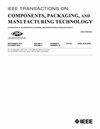热退火条件下微米尺度焊料互连器件中的空洞增长和金属间搭桥
IF 2.3
3区 工程技术
Q2 ENGINEERING, ELECTRICAL & ELECTRONIC
IEEE Transactions on Components, Packaging and Manufacturing Technology
Pub Date : 2024-06-19
DOI:10.1109/TCPMT.2024.3416430
引用次数: 0
摘要
随着 2.5-D/3-D 封装中微凸点间距和尺寸的减小,伴随着铜锡金属间化合物 (IMC) 相的生长,焊点体积中的空洞演变成为潜在的可靠性问题,因此有必要进一步研究其根本机制。在这项研究中,设计并制造了测试设备来模拟尺寸为 30~\mu $ m 的细间距微凸块的行为。因此,它们可以连续观察相演变。这些装置还消除了破坏性处理技术可能造成的信息丢失。每个制作好的测试设备都由多个带有不同尺寸锡焊段的铜-锡-铜接头组成,然后在 175~ {mathrm {^{\circ}C }}$ 的温度下老化 1000 小时,每 50 或 100 小时在扫描电子显微镜 (SEM) 下读取一次数据。此外,还使用聚焦离子束 (FIB) 在一些样品上铣出沟槽,以确定铜锰结点上各种材料相的特征,并监测它们随热老化而增长的情况。报告了这些研究的观察结果,并提出了一种反应-扩散机制来解释所观察到的铜-锰 IMC 和高温热老化引起的空隙演变。本文章由计算机程序翻译,如有差异,请以英文原文为准。
Void Growth and Intermetallic Bridging in Microscale Solder Interconnects Under Thermal Annealing
As the pitch and size of microbumps in 2.5-D/ 3-D packages decrease, void evolution in the solder joint volume accompanied by growth of Cu-Sn intermetallic (IMC) phase is a potential reliability concern necessitating further investigation into the underlying mechanisms. In this study, test devices are designed and fabricated to mimic the behavior of fine pitch microbumps of size
$30~\mu $
m. These test devices offer the capability of nondestructively observing IMC growth and void evolution. Consequently, they allow continuous observation of phase evolution. These devices also eliminate potential loss of information due to destructive processing techniques. Each fabricated test device consists of multiple Cu-Sn-Cu joints with varying sizes of Sn solder segments that are then aged at
$175~ {\mathrm {^{\circ}C }}$
for a total time of 1000 h, with readouts every 50 or 100 h under scanning electron microscope (SEM). Additionally, trenches are milled in some samples using focused ion beam (FIB) to characterize the various material phases at the Cu-Sn junctions and monitor their growth with thermal aging. The observations from these investigations are reported, and a reaction-diffusion mechanism is proposed to explain the observed Cu-Sn IMC and void evolution due to thermal aging at elevated temperatures.
求助全文
通过发布文献求助,成功后即可免费获取论文全文。
去求助
来源期刊

IEEE Transactions on Components, Packaging and Manufacturing Technology
ENGINEERING, MANUFACTURING-ENGINEERING, ELECTRICAL & ELECTRONIC
CiteScore
4.70
自引率
13.60%
发文量
203
审稿时长
3 months
期刊介绍:
IEEE Transactions on Components, Packaging, and Manufacturing Technology publishes research and application articles on modeling, design, building blocks, technical infrastructure, and analysis underpinning electronic, photonic and MEMS packaging, in addition to new developments in passive components, electrical contacts and connectors, thermal management, and device reliability; as well as the manufacture of electronics parts and assemblies, with broad coverage of design, factory modeling, assembly methods, quality, product robustness, and design-for-environment.
 求助内容:
求助内容: 应助结果提醒方式:
应助结果提醒方式:


